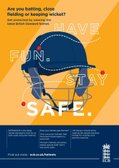
Helmet Safety Measures - ECB Guidance
The ECB has recently announced new helmet safety measures, which are being introduced with a view to reducing the risk of head and facial injuries within the game. The following information should assist Leagues and Clubs at the recreational level to understand the key elements of these changes and what they mean.
Players over the age of 18
The ECB strongly recommends that all adult recreational cricketers should wear helmets for certain activities, preferably which meet the most recent British Safety Standard (see below). This recommendation applies to batting against all types of bowling, wicket-keepers standing up to the wicket (who may as an alternative wear face protectors) and fielders fielding closer than eight yards from the batsman’s middle stump, except behind the wicket on the off side.
Under 18s
Since 2000, the ECB has published safety guidance regarding the wearing of head protectors by all cricketers under the age of 18. The ECB’s current guidance is that all cricketers under the age of 18 must wear a head protector whilst batting in matches or practice sessions. The ECB also now strongly recommends that junior players use head protectors which have been tested against the junior sized ball.
In brief, the guidance recommends that:
- helmets with a faceguard or grille should be worn when batting against a hard cricket ball in matches and in practice sessions
- young players should regard a helmet with a faceguard as a normal item of protective equipment when batting, together with pads, gloves and, for boys, an abdominal protector (box)
- young wicket keepers should wear a helmet with a faceguard, or a wicketkeeper face protector at all times when standing up to the stumps.
This guidance applies to all players up to the age of 18, both in open age group cricket and in all junior cricket played with a hard cricket ball. The guidance also applies during all practice sessions.
Any individual taking responsibility for any player(s) under the age of 18 should take reasonable steps to ensure this guidance is followed at all times. No parental consent to the non-wearing of a head protector should be accepted.
British Safety Standard
The latest British Safety Standard is BS7928:2013 (for both adults and juniors). The full list of helmets meeting this standard is available at www.ecb.co.uk/concussion-in-cricket/helmets For wicket-keeping face protectors the relevant British Safety Standard is BS7929-2:2009 (again, for both adults and juniors).
The ECB understands that there is currently no specific women’s helmet and as a consequence no specific standard for women’s cricket helmets. As the size of the standard women’s cricket ball is between the standard men and junior balls, it is recommended that women use helmets that have been tested against both the men’s and junior sized ball, or at least against the junior size ball (as that could potentially get through the gap above the face guard on a men’s helmet).
What do Leagues and Clubs need to do?
Whilst it is strongly recommended that all adult recreational cricketers wear helmets in the on-field circumstances detailed above, it is not mandatory for them to do so. For the avoidance of doubt, Leagues or Clubs do not need to go above and beyond the ECB’s recommendation by forcing their cricketers to wear helmets.

